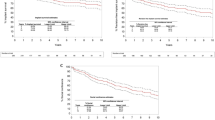Abstract
We present 1-year results obtained with Reemex for the cure of intrinsic sphincter deficiencies (ISDs). We recruited all patients with primary cases of stress urinary incontinence (SUI) due to an ISD (Valsalva leak-point pressure less than 60 cm or maximal urethral closure pressure less than 20 cm) who did not receive previous surgery. Thirty-eight patients were operated on. Postoperative pain was 3 (range, 1–5, visual analogue scale) at 24 h from surgery. Immediate regulation (the day after surgery) was necessary in three of 38 patients (7.9%), two for obstructive voiding difficulties and one for incontinence. Late regulation was necessary in three of 38 patients (7.9%), two for obstructive voiding difficulties (after 6 months) and one for incontinence (1 year). Symptoms resolved after the sling adjustment. Our results suggest that sling adjustments resolve postoperative failures and maintain the success rate of the Reemex system even in the midterm.
Similar content being viewed by others
References
Ulmsten U, Falconer C, Johnson P, Jomaa M, Lanner L, Nilsson CG et al (1998) A multicenter study of tension-free vaginal tape (TVT) for surgical treatment of stress urinary incontinence. Int Urogynecol J Pelvic Floor Dysfunct 9(4):210–213
Ulmsten U, Johnson P, Rezapour M (1999) A three-year follow up of tension free vaginal tape for surgical treatment of female stress urinary incontinence. Br J Obstet Gynaecol 106(4):345–350
Nilsson CG, Kuuva N, Falconer C, Rezapour M, Ulmsten U (2001) Long-term results of the tension-free vaginal tape (TVT) procedure for surgical treatment of female stress urinary incontinence. Int Urogynecol J Pelvic Floor Dysfunct 2(12 Suppl):S5–S8
Kuuva N, Nilsson CG (2002) A nationwide analysis of complications associated with the tension-free vaginal tape (TVT) procedure. Acta Obstet Gynecol Scand 81(1):72–77
Agostini A, Bretelle F, Franchi F, Roger V, Cravello L, Blanc B (2006) Immediate complications of tension-free vaginal tape (TVT): results of a French survey. Eur J Obstet Gynecol Reprod Biol 124(2):237–239
Delorme E, Droupy S, de Tayrac R, Delmas V (2004) Transobturator tape (Uratape): a new minimally-invasive procedure to treat female urinary incontinence. Eur Urol 45(2):203–207
Costa P, Grise P, Droupy S, Monneins F, Assenmacher C, Ballanger P et al (2004) Surgical treatment of female stress urinary incontinence with a trans-obturator-tape (T.O.T.) Uratape: short term results of a prospective multicentric study. Eur Urol 46(1):102–106
Ghoniem G, Shaaban A (1994) Sub-urethral slings for the treatment of stress incontinence. Int Urogynecol J 5:228–229
Iglesias X, Espuna M (2003) Surgical treatment of urinary stress incontinence using a method for postoperative adjustment of sling tension (Remeex system). Int Urogynecol J Pelvic Floor Dysfunct 14:326–330
Martin Martinez A, Medina Ramos N, Cerezuela Requena JF, Garcia Hernandez JA (2003) Analysis of retropubic colpourethrosuspension results by suburethral sling with Remeex prosthesis. Eur J Obstet Gynecol Reprod Biol 106:179–183
Abrams P, Cardozo L, Fall M, Griffiths D, Rosier P, Ulmsten U et al (2002) The standardisation of terminology of lower urinary tract function: report from the standardisation sub-committee of the International Continence Society. Neurourol Urodyn 21:167–168
Abrams P (2000) Assessment and treatment of urinary incontinence: Scientific Committee of the First International Consultation on Incontinence. Lancet 355(9221):2153–2158
McGuire EJ, Cespedes RD, O'Connell HE (1996) Leak-point pressures. Urol Clin North Am 23(2):253–262
McGuire EJ (1995) Urodynamic evaluation of stress incontinence. Urol Clin North Am 22(3):551–555
Sriwatanakul K, Kelvie W, Lasagna L et al (1983) Studies with different types of visual analog scales for measurement of pain. Clin Pharmacol Ther 34(2):234–239
Golomb J, Shenfeld O, Shelhav A, Ramon J (1997) Suspended pubovaginal sling for the correction of complicated stress urinary incontinence. Eur Urol 32:170–174
Zaragoza MR (1996) Expanded indications for the pubovaginal sling: treatment of type 2 or 3 stress incontinence. J Urol 156(5):1620–1622
McGuire EJ, Bennett CJ, Konnack JA, Sonda LP, Savastano JA (1987) Experience with pubo-vaginal slings for urinary incontinence in the University of Michigan. J Urol 138:525–526
Stanton SL (1985) Silastic sling for urethral sphincter incompetence in women. Br J Obstet Gynaecol 92:747–750
Bidmead J, Cardozo L (2000) Sling techniques in the treatment of genuine stress incontinence. Br J Obstet Gynaecol 107:147–156
Blaivas JC, Jacobs BZ (1991) Pubovaginal fascial sling for the treatment of complicated stress urinary incontinence. J Urol 145:1214–1218
Wilson TS, Lemack GE, Zimmern PE (2003) Management of intrinsic sphincteric deficiency in women. J Urol 169(5):1662–1669
Conflicts of interest
None.
Author information
Authors and Affiliations
Corresponding author
Rights and permissions
About this article
Cite this article
Araco, F., Gravante, G., Dati, S. et al. Results 1 year after the Reemex system was applied for the treatment of stress urinary incontinence caused by intrinsic sphincter deficiency. Int Urogynecol J 19, 783–786 (2008). https://doi.org/10.1007/s00192-007-0523-5
Received:
Accepted:
Published:
Issue Date:
DOI: https://doi.org/10.1007/s00192-007-0523-5




